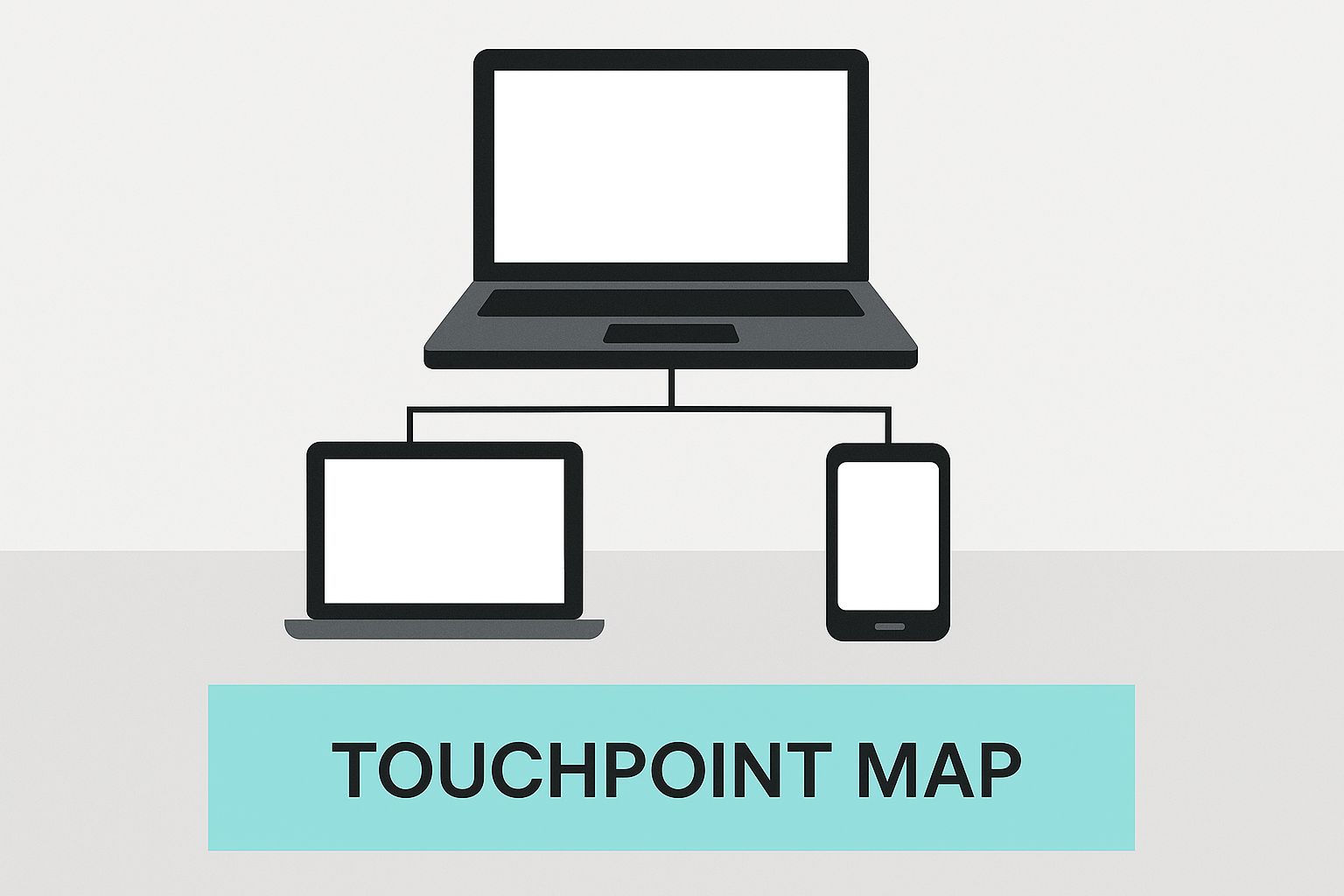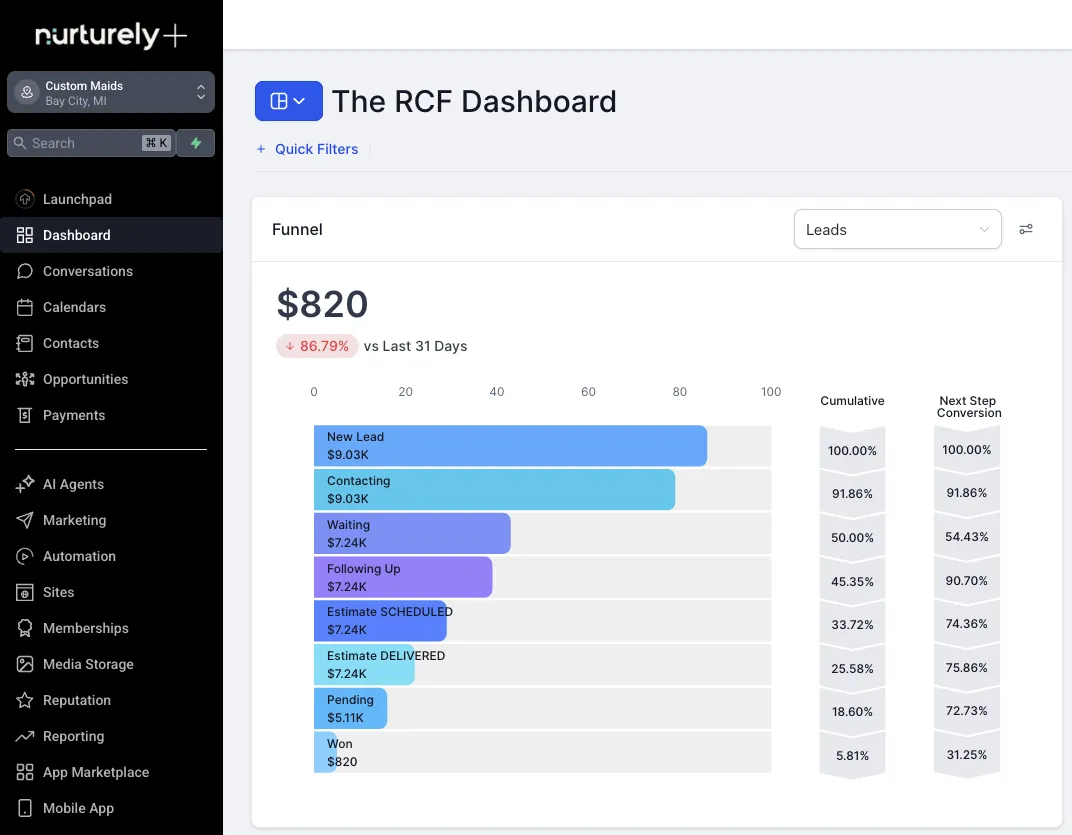Customer Journey Management
Mastering Customer Journey Management
Think about your customer's experience for a second. Is it a single, isolated transaction? Or is it more like a road trip?
I've learned that customer journey management is the art of being their trusted guide at every single stop. It's about making sure the entire trip is smooth, memorable, and ultimately turns them into a lifelong fan of your brand.
Why Customer Journey Management Matters Right Now

In a market this crowded, focusing only on one-off sales is like paving the first ten feet of a thousand-mile highway. It's shortsighted. Real, sustainable growth comes from understanding and improving the entire route your customer takes with you. This is where a customer-first approach isn't just a nice-to-have; it's everything.
This isn't just a hunch; the numbers back it up. The global customer journey analytics market, valued at around USD 17.91 billion in 2025, is projected to explode to USD 47.06 billion by 2032. This tells a clear story: businesses are betting big on understanding the full experience to drive loyalty and lifetime value. If you're curious, you can explore more about these market trends and what they mean for companies like yours.
The Power of Orchestrated Touchpoints
A touchpoint is any time a person interacts with your business. It could be seeing a social media ad, reading a review, clicking around your website, or chatting with your support team. The magic of customer journey management is identifying all these little moments and orchestrating them so they tell a single, coherent story.
"A journey map is the visual story of your customer's experience. Management is the act of making sure that story has a happy ending—for both the customer and your business."
Without this orchestration, things get messy. A customer might see an awesome promo on Facebook, but then land on a clunky website that's impossible to navigate. That gap between promise and reality creates frustration. A well-managed journey ensures every interaction builds on the last, creating trust and momentum.
Customer Journey Management vs Traditional Marketing
To really grasp this shift, it helps to see how different this approach is from the old way of doing things. Traditional marketing was all about casting a wide net and shouting a message. Customer journey management is about building a relationship, one touchpoint at a time.

The table makes it clear: we're moving from a world of short-term wins to one where long-term customer value is the ultimate prize.
From Silos to Synergy
One of the biggest hurdles I see businesses face is internal silos. Marketing handles the ads, sales handles the closing, and support cleans up any problems afterward. The issue? These teams often operate in their own little worlds, creating a disjointed experience for the customer who, by the way, only sees one company.
Customer journey management shatters these walls. It forces teams to rally around a single shared goal: making the customer's experience seamless. When that happens, you get:
Consistent Messaging: Your brand's voice and promises are the same, whether it's on an ad, an email, or a support call.
Proactive Problem-Solving: Teams start spotting potential friction points and fixing them before they blow up into major issues.
Increased Loyalty: A smooth, predictable journey builds trust. It makes customers feel seen and valued, turning them into your best advocates.
By embracing customer journey management, you stop just selling things and start building genuine relationships. This holistic view isn't a luxury anymore; it's the core engine for sustainable growth for any business that wants to win today.
Understanding the Five Stages of the Rustomer Journey
If you want to manage the customer journey, you have to know the route first. Think of it like a road trip—if you don't know the key stops and what to expect at each one, you're not going to be a very good guide. The customer journey is typically broken down into five distinct stages, and each one comes with its own unique customer mindset, questions, and behaviors.
This isn't about just pushing people through a funnel. True customer journey management is about understanding what someone needs at each specific phase and meeting them right there, with the right information, on the right channel, and at the right time.
Let's walk through the five stages that form the backbone of this whole process.
Stage 1: Awareness
This is the "I have a problem" stage. A potential customer isn't looking for your brand or even a solution like yours just yet. They're just becoming aware of a need, a nagging pain point, or a new desire. Their search is broad and informational.
For example, a homeowner might notice their energy bills are suddenly through the roof. They aren't Googling "Nurturely HVAC services" at this point. Instead, they're typing things into Google like "why is my electric bill so high?" or "how to make my home more energy efficient."
Your goal here is simple: be a helpful resource. The key is to create genuinely valuable content that answers their initial questions without a hard sell.
Blogging: Write articles that dig into the common problems your customers face.
Social Media: Share quick tips and simple insights that speak directly to their pain points.
SEO: Make sure your content is optimized for those broad, problem-focused keywords.
Stage 2: Consideration
Okay, now things are getting serious. The customer has put a name to their problem and is actively researching how to solve it. They’ve gone from "I have a problem" to "What are my options for fixing this?" They're comparing different products, services, and companies head-to-head.
Our homeowner is now looking at HVAC systems, insulation services, and maybe even energy-efficient windows. They're digging into reviews, watching comparison videos, and clicking through company websites. This is no surprise—research shows that a whopping 81% of shoppers do online research before making a significant purchase.
This is your moment to show them exactly why your solution is the one they should choose.
Your job in the Consideration stage is to build trust and demonstrate value. Provide detailed information that helps the customer make an informed decision, positioning your brand as the expert guide they've been looking for.
Stage 3: Purchase
The customer is ready to pull the trigger. They’ve done their homework, weighed the options, and likely have it narrowed down to you and maybe one other competitor. Their focus shifts from "what" to "how." They are looking for a smooth, simple, and frictionless path to becoming a paying customer.
Any friction at this stage can be fatal to the sale. A clunky checkout process, unexpected fees popping up at the last second, or a payment page that takes forever to load can send them running straight to your competitor. A seamless experience is non-negotiable.
This is especially true in a world where customers move between devices. They might start on their phone and finish on a laptop, and the experience needs to be consistent.

As you can see, the modern purchase isn't a straight line on a single device. It's a web of interactions, and each one needs to feel connected.
Stage 4: Retention
The journey doesn't stop once the payment goes through—in fact, this is where real, lasting loyalty is forged. The Retention stage is all about delivering on the promises you made and making sure the customer has a fantastic post-purchase experience. Their mindset shifts to, "Did I make the right choice?"
This phase covers everything from onboarding and customer support to proactive check-ins to make sure they're happy. A great product can be completely torpedoed by bad service. On the flip side, excellent service can turn a minor product hiccup into a moment that builds even stronger loyalty. For service businesses, this is how you lock in repeat business and valuable service contracts.
Stage 5: Advocacy
This is the ultimate goal—the final and most powerful stage of the customer journey. Advocacy is what happens when a happy, satisfied customer becomes a proactive champion for your brand. They don't just stick with you; they go out and actively tell other people about you.
These are the customers who leave glowing reviews without being asked, refer friends and colleagues, and even defend your brand on social media. They become your most effective—and most cost-efficient—marketing channel. You can nudge this along by:
Requesting reviews: Make it incredibly easy for happy customers to share their feedback.
Implementing referral programs: Reward your loyal customers for bringing new business your way.
Building a community: Create a space, like a Facebook group or online forum, where your best customers can connect with you and each other.
By truly understanding and optimizing these five stages, you can turn customer journey management from just another industry buzzword into a practical system for real, sustainable growth.
How to Build Your First Customer Journey Map
Alright, let's turn theory into something you can actually use. A customer journey map is where it all becomes real—a visual tool that tells the story of what it's really like to be one of your customers.
This is more than just a flowchart. It’s the first practical step in real customer journey management. It forces you to see your business through their eyes, helping you find the exact moments where you shine… and the spots where things are quietly falling apart.
The goal here isn't to create a pretty diagram. It's to build a living document that uncovers hidden frustrations and pinpoints those game-changing opportunities. Think of it as the blueprint for making every single interaction better.
Step 1: Start with a Clear Persona
You can't map a journey for "everyone." That's a recipe for a vague, useless map. The real power comes from focusing on one specific type of customer. So, you have to start by creating a clear customer persona.
If you run a cleaning company, this might be "Busy Professional Brenda." She's a 35-year-old working parent who cares more about convenience and trust than anything else. For an HVAC business, it could be "Emergency Eric," a homeowner whose AC just died in the middle of July. He's panicking and needs help, fast.
Giving your persona a name and a story makes it so much easier to step into their shoes and understand their goals and frustrations.
Step 2: Outline the Journey Stages
With "Brenda" or "Eric" in mind, list out the big-picture stages they go through. This will generally follow the classic path—awareness, consideration, purchase, and so on—but you need to tailor it to your business.
For "Busy Professional Brenda," the stages might look like this:
Realization: "My house is a disaster, and I have zero time to clean it."
Discovery: Googling "house cleaning services near me."
Evaluation: Clicking through websites, scanning reviews, and asking for quotes.
Booking: Scheduling that first appointment.
Service: The moment of truth—the actual cleaning.
Follow-Up: Getting a feedback survey and a reminder about her next service.
Step 3: Identify All Customer Touchpoints
Now it’s time to get granular. For each of those stages, list every single place your persona interacts with your company. These are your touchpoints. No interaction is too small, because even the tiny ones add up to shape the overall experience.
A touchpoint isn't just a website visit or a phone call. It includes every ad, email, text message, review, social media post, and in-person interaction. Mapping these reveals the true complexity of the customer's path.
For instance, during Brenda's "Evaluation" stage, her touchpoints could be:
Your Google Business Profile and its reviews.
Your website’s homepage and service pages.
The form she fills out to request a quote.
The automated email confirming her request was received.
A follow-up phone call from your team.
Step 4: Gather Your Data and Insights
Here’s the critical part. A journey map built on guesses is just a story you made up. To make it a powerful business tool, you have to ground it in real data. This is where you connect what customers do with what they’re thinking and feeling.
You’ll need to pull from a few different places:
Analytics: Use your website and social media data to see where people are going and, more importantly, where they’re giving up.
Surveys: Just ask! Simple feedback surveys can give you direct insight into their experience.
Customer Interviews: Talk to a handful of real customers who fit your persona. Ask them open-ended questions and just listen to their story.
Team Feedback: Your sales, support, and service teams are on the front lines. They know the common questions, complaints, and frustrations better than anyone.
This is where an all-in-one platform becomes your best friend, because it puts all this information in one place. You can literally trace a lead's entire history—from their first click on your site to their latest support ticket—with a premium CRM designed for small businesses.
Step 5: Assemble the Map
Once your research is done, it's time to put it all together. You don't need fancy software; a simple spreadsheet or a table works great for your first map. If you want a head start, a good Customer Journey Mapping Template can give you a solid structure to build from.
Create columns for each journey stage. Then, for each stage, add rows for:
Actions: What is the customer actually doing? (e.g., Clicks on an ad, calls for a quote)
Thoughts: What’s going through their head? (e.g., "Is this company legit? Is the price fair?")
Feelings: What emotions are they experiencing? (e.g., Anxious, curious, relieved)
Pain Points: Where are the moments of friction? (e.g., Confusing pricing, slow to respond)
Opportunities: How can you make this step better? (e.g., Offer instant online booking, send a text confirmation)
Once you've filled this out, you'll have more than a map. You'll have a strategic guide for making smarter decisions and mastering your customer journey management.
From Static Maps to Dynamic Journey Orchestration
Having a customer journey map is a great first step. Seriously. It gives you a clear picture of the customer's path, showing you their actions, what they're feeling, and where they get stuck. But a map, on its own, is a static document. It shows you the road, but it doesn't let you guide traffic in real time.
This is where the real shift in customer journey management is happening.
The most forward-thinking companies are moving from just analyzing the journey to actively shaping it as it unfolds. It’s the difference between having a blueprint of a house and being the smart home system that adjusts the lights and temperature on its own.
The Leap to Journey Orchestration
Journey orchestration is the tech-driven process of actively guiding customers along their path with personalized, real-time interactions. It uses data and automation to guess what a customer needs next and respond instantly.
Think of it like a GPS that doesn't just show you the route but reroutes you on the fly to avoid a sudden traffic jam.
For example, a static map might tell you that customers often click back and forth between two product pages. It would label this a "consideration phase pain point." That's useful information, but an orchestrated journey takes action. The system sees this behavior as indecision and automatically triggers a live chat window offering a product comparison guide or a simple "Can we help?" message.
That dynamic response turns a moment of frustration into a helpful conversation, building trust and nudging the customer toward a confident decision.
How Technology Powers Real-Time Responses
The engine running all of this is a new wave of customer journey analytics and orchestration (CJA/O) tools, often baked right into modern CRMs. These platforms don't just hold customer data; they're constantly analyzing it to trigger smart, automated actions.
This isn't just a small trend. A 2025 Market Guide from Gartner shows that businesses are quickly adopting CJA/O solutions to get a handle on complex, multi-channel journeys. It’s a huge shift from static mapping to continuous, dynamic optimization. You can discover key takeaways from the Gartner guide and see how this is reshaping the market.
Journey orchestration is about closing the gap between insight and action. It’s the system that ensures no customer falls through the cracks, no matter how complex or unpredictable their path becomes.
Platforms like Nurturely bring this to life. They connect all your touchpoints—website visits, email opens, social media DMs, and support tickets—into one unified place. This allows you to build powerful "if-then" automation that works across the entire customer experience.
Practical Examples of Journey Orchestration
Let's look at how this plays out in the real world:
Proactive Support: A customer keeps visiting your help center page about a specific issue but never actually opens a support ticket. The system flags this and automatically sends them an email: "Still having trouble with [Issue]? Let's solve it together," with a direct link to book a call.
Intelligent Upselling: A client in your lawn care business always opens emails about seasonal pest control but has never bought the service. Your system can add them to a short, targeted campaign offering a special bundle discount on their next scheduled service.
Preventing Churn: A long-time customer’s engagement suddenly drops. They haven’t opened an email or logged into their account in 60 days. An orchestrated workflow can alert their account manager to reach out personally, stopping a potential loss before it’s too late.
This level of hyper-personalization at scale used to be a pipe dream. Now, it’s becoming the new standard for effective customer journey management, letting you create countless small moments of delight that build lasting trust and drive real growth.
So you’ve decided to manage your customer journey. That's a huge step. But even with the best plan in the world, you're almost guaranteed to hit a few bumps in the road. It’s just part of the process.
Most businesses don’t get stuck because they lack desire. They get stuck on the same predictable roadblocks: internal squabbles, messy data, and the age-old question, "Is this actually making us money?"
Knowing these challenges are coming is half the battle.

Breaking Down Departmental Silos
The classic, and maybe biggest, hurdle is the departmental silo. Marketing, sales, and customer support often live in entirely separate worlds. They have their own goals, their own language, and their own metrics.
This creates a jarring, disjointed experience for the one person who matters most: the customer. To them, you're just one company. They don't know or care about your internal org chart.
Imagine a customer has a fantastic conversation with a salesperson. They're excited. Then they're handed off to an onboarding process that's confusing, followed by a support team that has zero context for anything that's happened before. That friction doesn't just feel bad; it actively erodes trust.
The only way to fix this is to build a culture around a single, shared mission: the customer's success.
Create Cross-Functional "Journey Teams": Pull people from marketing, sales, and support to own specific stages of the journey together.
Share Goals and Metrics: Stop obsessing over department-specific targets. Align everyone around customer-centric KPIs like satisfaction scores (CSAT), Net Promoter Score (NPS), and Customer Lifetime Value (CLV).
Use a Unified Platform: A single source of truth, like an all-in-one CRM, is non-negotiable. When everyone from sales to support is looking at the same customer history in Nurturely, the silos naturally start to crumble.
Unifying Data into a Single Customer View
The next major obstacle is data chaos. Customer information is everywhere—scattered across your marketing automation tool, the sales CRM, a separate helpdesk platform, and probably billing software, too. Without one unified view, understanding the complete journey is just guesswork.
This isn't a new problem, but it's a persistent one. In fact, a recent report from The State of Customer Journey Success found that integrating real-time data is still one of the top roadblocks for businesses, right alongside breaking down those silos and proving ROI.
True customer journey management is impossible when your data lives in separate kingdoms. Unification is not a 'nice-to-have'; it is the absolute foundation for understanding and improving the customer experience.
This is where the right technology becomes your best friend. An all-in-one platform is designed to connect these dots for you, automatically consolidating every single touchpoint into one chronological timeline for every contact. No more digging through three different systems to piece together a customer's story.
Proving the Return on Investment
Finally, we get to the bottom line. It can be surprisingly tricky to prove the financial return of making the customer journey better. Your leadership team needs to see hard numbers that connect your efforts to actual business results. Vague promises about "better experiences" just won't cut it when budgets are on the line.
You have to draw a straight line from your journey management activities to concrete business outcomes.
Track Churn Reduction: Show how improvements in the retention stage—like better onboarding or proactive support—have lowered the percentage of customers canceling. A lot of platforms can even help you automate customer support to deliver faster, more consistent service that keeps people happy.
Measure Increased Lifetime Value: Demonstrate that customers who have a smoother ride end up spending more money over time. Do they buy more, add services, or upgrade their plans? Track it.
Link to Revenue Growth: Connect specific journey improvements, like a simplified checkout process, directly to higher conversion rates or an increase in referrals from happy customers.
When you focus on these metrics, you shift the conversation. Customer journey management stops looking like a cost center and starts looking like what it really is: a powerful engine for business growth.
A brilliant customer journey map is your blueprint, but an all-in-one platform is the construction crew that actually builds the experience. A great plan is just a piece of paper without the right tools for execution—the tools that connect all the dots and turn your map into a living, breathing, revenue-driving reality.
Let’s walk through how a unified system like Nurturely makes customer journey management a practical, day-to-day activity at every single stage.
Powering the Awareness and Consideration Stages
During the Awareness stage, your only job is to be a helpful resource. With an integrated platform, you can launch targeted social media campaigns or blog posts straight from your dashboard. As people engage, they’re automatically captured as leads in your CRM, officially kicking off their journey with you.
This flows right into the Consideration stage. Once a lead shows real interest—say, by downloading a guide—the system can automatically trigger a nurture sequence. This isn't just another generic email blast. We're talking about a series of targeted messages designed to answer their specific questions, building trust and positioning you as the obvious expert.
This kind of automation ensures no lead gets forgotten, and every single prospect gets the information they need to move forward with confidence.
You can get a bird's-eye view of all your active campaigns and see who's engaging right from the system's dashboard.
A visual like this shows you at a glance which leads are moving through your sequences, letting you track progress and spot any bottlenecks in real-time.
Creating a Frictionless Purchase and Retention Experience
When a customer is ready to buy, friction is your biggest enemy. The Purchase stage has to be absolutely effortless. An all-in-one platform connects your proposal and invoicing tools directly to the customer's record. You can send a quote and let them pay online, all within a single, professional experience that reflects your brand.
Once the sale is made, the journey shifts to Retention, which is where the real long-term value is built. This is where managing the post-purchase experience becomes critical. With a unified system, the customer’s entire history is in one place. When they reach out for support, your team has the full context, which leads to faster, more effective resolutions. This is where you can apply proven customer service improvement strategies to create interactions they'll actually remember.
A great customer journey doesn't end at the sale. It begins a new chapter focused on delivering value, solving problems proactively, and ensuring the customer feels confident in their decision.
You can even automate key retention touchpoints. For instance, a fantastic way to kick off this phase is to streamline your new client onboarding process today with automated welcome sequences and check-ins, making new customers feel valued from the moment they say yes.
Activating Your Happiest Customers as Advocates
The final—and most powerful—stage is Advocacy. Your unified system holds the key to figuring out who your biggest fans are. By tracking satisfaction scores, positive interactions, and repeat business, the platform can automatically flag your happiest clients.
This isn't guesswork; it's data telling you who loves what you do. From there, you can set up an automated workflow that invites these brand champions to leave a review, join a referral program, or even participate in a case study. This systematic approach turns your best customers into a predictable and powerful marketing engine, bringing your entire customer journey management strategy full circle.
Of course. Here is the rewritten section, designed to sound like an experienced human expert while matching the style and tone of the provided examples.
Got Questions? We've Got Answers
Whenever you start digging into customer journey management, a few common questions always pop up. Let's tackle them head-on so you can get a clear picture and start making progress.
What’s the Real Point of All This?
Honestly, the main goal is to create an experience that feels consistently good and connected for your customers, no matter how they interact with you. We're not just looking at single sales anymore.
It's about understanding the entire lifecycle—from the moment someone first hears about you to long after they've become a loyal fan. When you get that right, you build real relationships, earn powerful loyalty, and set yourself up for growth that actually lasts.
Journey Map vs. Sales Funnel: What’s the Difference?
I see this one all the time, and it’s a crucial distinction. A sales funnel is all about your perspective as a business. It’s a straight line, tracking how you move a prospect from one stage to the next, usually ending with a sale.
But a customer journey map? That’s all about the customer's perspective. It’s messy, non-linear, and way more holistic. It captures what they’re actually doing, thinking, and feeling—before, during, and even long after a purchase. It gives you a much richer, more human-centered view of what's really happening.
How Do I Even Get Started?
Jumping into customer journey management can feel like a huge task, but it doesn't have to be. The trick is to start small and focused. Seriously, keep it simple.
Pick One Persona: Don't try to map everyone at once. Just choose one of your key customer types to start.
Sketch Out the Stages: What are the big phases they go through? Think initial awareness, consideration, purchase, and what happens afterward.
List Key Touchpoints: Brainstorm the main ways they interact with your brand at each of those stages. Website, social media, a phone call, an email—list them out.
Find the Low-Hanging Fruit: Look at your basic website analytics, for sure. But the real gold? Talk to your sales and support teams. They're on the front lines and know exactly where customers get stuck or frustrated.
This first, simple map will immediately give you things you can act on.
Ready to stop juggling a dozen different tools and start managing your entire customer journey from one place? Nurturely Plus combines every software you need—from lead capture and sales pipelines to marketing automation and payments—into a single, powerful platform. See how Nurturely Plus can help you grow faster today.



